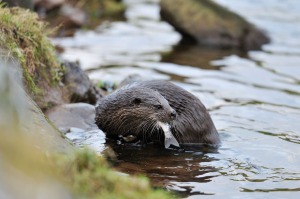I started off 2013 with 17 khaki Campbell ducks, which I increased to 25 in July by buying 8 young ones due to start to lay around mid-December. In early November I ‘pensioned off’ 8 two-year old ducks to nearby Gloagburn Farm Shop pond, bring my stock down to 17 again. I blogged recently about four ducks being taken by an otter, reducing my stock to 13. Things have taken a turn for the worse.
When I went to put my ducks in to their shed about 5.00 pm yesterday they were at the furthest end of the wood. This was unusual as they are normally either waiting to go in to their shed or have already gone in. They were reluctant to be driven towards the shed, twice breaking back in the dark before I eventually coaxed them to the bridge over the burn and into their shed. This done, I checked through the wood with the torch in case I had missed any and was happy they were all safely locked in.
In the morning, with the advantage of daylight, I counted them out of the shed. Eleven ducks. I checked the wood again and down the burn, but no trace of the missing two. I have no doubt that the otter was back again yesterday during daylight and panicked two into squeezing through the grid from the pond into the main burn and to their inevitable fate when the otter followed.
Jan, my wife, was really upset, but as I told her there is nothing we can do except the impractical solution of standing guard all day. Otters are extremely well protected and I am sure I am not the only person who is in this frustrating position, not that I would want to harm an otter in any case. For those who read this blog it is maybe an opportune time to explain the protection that otters have.
Otters are protected under Conservation (Natural Habitats etc) Regulations 1994, amended and strengthened in Scotland by further regulations in 2004 and 2007. The otter is included in Schedule 2 to the Regulations as a European Protected Species. It is therefore an offence to deliberately or recklessly capture, injure or kill an otter, which of course would preclude me from live-trapping it and moving it elsewhere (a daft option in any case as it would soon be replaced by another one). I would not be allowed to deliberately or recklessly harass it, though earlier this year when I ran at one shouting and waving a stick when it was amongst the ducks on the pond I may have been coming close to that!
In addition to these offences, which severely limit what I can do to protect my ducks, an otter’s place of shelter (its holt) is protected and a person may not possess, offer for sale or sell a dead otter or any part of it if it was obtained after 2007. Anyone now picking up a dead otter off the road for taxidermy purposes or to use its head for a sporran would now commit an offence. Further, anyone in Scotland in possession of a dead otter or part of an otter (taxidermied specimen or sporran etc), if the otter was legally taken after 10 June 1994 – the date of the enactment of the Conservation (Natural Habitats etc) Regulations – must apply to Scottish Natural Heritage for a licence to continue to hold it. The licence can only be granted where it can be shown that, at the time of taking a specimen, or part, from the wild, the act of taking the specimen would not have been an offence. It may be that a licence would not be granted unless the specimen is for scientific, research or educational purposes.

